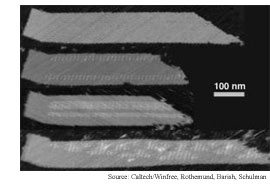
 |
 |
 |
 |
DNA
builds by design
 Heat
up the right DNA strands and let them cool slowly, and you're a step closer
to growing complicated objects in a test tube.
Heat
up the right DNA strands and let them cool slowly, and you're a step closer
to growing complicated objects in a test tube. The programmable DNA assembly technique builds ribbons of DNA molecules. The ribbons are interconnected DNA tiles, which are themselves interconnected DNA molecules. A 70-nanometer-wide block of tiles triggers the assembly process, and the properties of ribbons are determined by this seed block's structure.
The process begins with a heated solution of free-floating DNA molecules. Partially cooling the solution causes the seed block and other tiles to form. Further cooling triggers the ribbon-growing process.
The process can produce ribbons containing binary codes. The technique, combined with DNA's ability to bind to other molecules, nanotubes and nanoparticles, opens a route to programmed self-assembly of objects. Possibilities include computer chips, data storage devices and drug delivery devices.
Research paper:
An Information-Bearing Seed for Nucleating Algorithmic Self-Assembly
Proceedings of the National Academy of Sciences, published online March 24, 2009
Researchers' homepage:
The DNA and Natural Algorithms Group, Caltech
Related stories and briefs:
Programmed DNA forms fractal -- precursor research
Back to TRN home
View from the High Ground Q&A
How It Works
RSS Feeds:
News
Ad links: Clear History
Buy an ad link
© Copyright Technology Research News 2000-2010. All rights reserved.